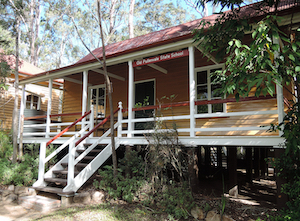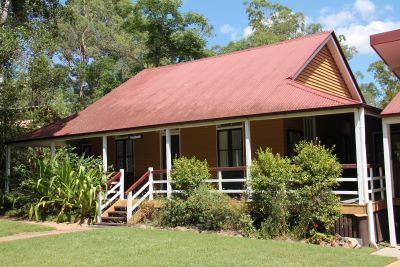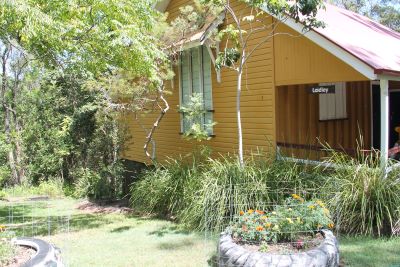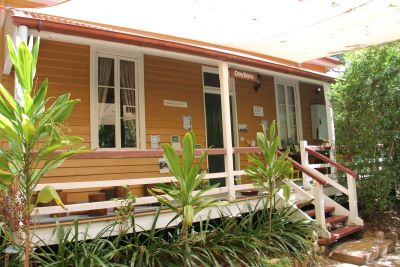PEEC opened as an Education Department Environmental Education Centre in 1982 in the grounds of the original Pullenvale State School located on a 2 acre site at the rural western edge of Brisbane.
The Centre has grown from two buildings (Old School and Residence) in 1981 to now include a collection of historic buildings moved from other locations and then restored (Redbank State School Residence; Laidley South State School and Lunch Shed; Dayboro State School Residence and Kitchen; Forest Gate Cottage; Ballard Cottage; Holt family Slab Hut).
The site has also been extensively landscaped over the past 32 years with a diverse range of native plants and trees to create a rich and bio-diverse learnscaped garden and forested setting where the historic buildings are nestled into a series of terraced teaching and story sites.
Old Pullen Vale School
The Pullenvale State School was first opened on the corner of Herron and Haven Roads in 1874. In 1906, it was moved approximately 1km to it's present location on Grandview Road. In 1982, when the Pullenvale Environmental Education Centre opened, the Old School and the Old School Teacher's Residence (now known as the Arts Office) were the only two buildings on the site. Over the next 20 years, PEEC's first principal collected several other historic buildings to house on the site. The Old School is currently used in the Year 5 Hoodwinked program, and the Year 2 History Hunters program.
 Arts Office
Arts Office
The building now known as 'the Arts Office' is the original Pullen Vale School Teacher's residence building, and is one of the two original buildings on the Old Pullenvale School site. It is currently used for Artist in Residence programs, as well as for the Kindy programs Kindy on Country and Tulmur Outdoor Classroom Day; the Prep program, Ramble and Play; and the professional development courses, Connected Teacher and Connected Leader.
 Redbank Plains State School Teacher's Residence
Redbank Plains State School Teacher's Residence
Redbank Plains State School opened in 1874 and like many rural schools in this period, the site also housed the teacher of the school. Relocated from Redbank Plains circa 1985, this old teacher's residence now operates as the PEEC Administration office.
 Forest Gate Cottage
Forest Gate Cottage
Relocated from the Harris pineapple farm in Pullenvale circa 1990, this building now operates as PEEC teacher staff rooms.
 Laidley South State School
Laidley South State School
Laidley South State School opened in 1896, and this building was the key teaching location. Relocated from Laidley in the Lockyer Valley (circa 1985), the old school building is now used as the 'theatre' within which students meet their 'mentor character' and/or 'contested character' (the character they will guide or give advice to) for several programs, including the Year 2 Muddles, Year 3 Mission Earth, Year 4 Bugs 'R' Us and Student Leadership Day programs.
 Dayboro State School Teacher's Residence
Dayboro State School Teacher's Residence
Dayboro State School opened in 1874, and like many rural schools in this period, the site also housed the teacher of the school. Relocated from Dayboro in the Samford Valley (circa 1985), this teacher's residence is now used in the Year 1 Forest Kingdom and the Year 5 Hoodwinked programs.
 Dayboro State School Kitchen
Dayboro State School Kitchen
Dayboro State School opened in 1874, and like many rural schools in this period, the site also housed the teacher of the school. Kitchens were often located in a separate building to the main residence during this period, due to risk of fire from the use of the wood stove. Relocated from Dayboro (circa 1985), this building is now used to support programs that run in the Laidley theatre and lunch shed.
 Ballard Cottage
Ballard Cottage
Donated by the Ballard family and relocated from their family farm in Pullenvale circa 1990, this building has recently been restumped and restored. It is now used in the Year 2 History Hunters program. It contains many artefacts from late 19th and early 20th century farmhouse life.
Holt family Slab Hut
This building was donated by the Holt family, disassembled in it's original location in Mount Crosby, and reassembled on the PEEC grounds (circa 1990) to mirror it's original construction, which dates back to the 1850s. It is an example of the huts built by the very early farmers and settlers in the south Brisbane area. It is currently visited by Year 2 students as part of the History Hunters program.